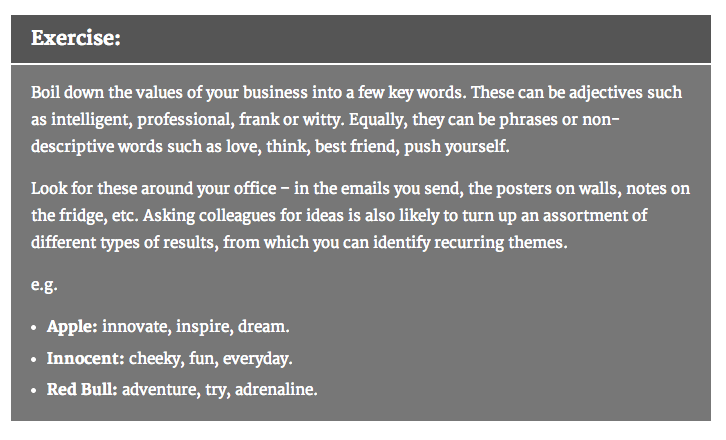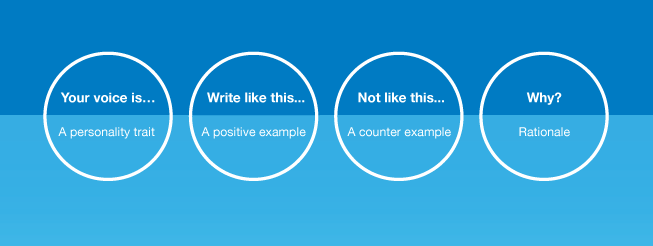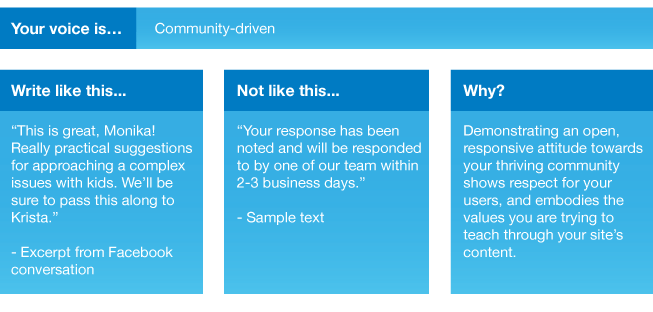
How to Find Your Social Media Marketing Voice: The Best Examples, Questions and Guides
Former VP of Marketing @ Buffer
Among the many ways to stand out on social media—killer content, amazing visuals, specific formatting, and more—one that often gets overlooked is voice.
We don’t want brands talking at us as if we are dollar signs. We want authentic communication.Finding a voice for your social media marketing can be difficult because the concept is somewhat unlike other optimization strategies online. Voice is not a statistic you can track or a design element you can tweak. Voice goes deeper than that. Instead of tracking and analyzing, you can plan and practice. Here’s what I’ve found works best in terms of getting your voice together and using it to interact online.
What is the difference between voice and tone?
When you jump into the discussion of voice in social media marketing, you can’t help but touch on tone as well. The two go hand-in-hand and are often used interchangeably. In this sense, it’s less important what the definitions are as long as you have definitions. You’ll be better off knowing where you’re headed with a well-defined direction.
The definitions that make the most sense to me are the ones that note a difference between voice and tone. Gather Content breaks down the difference in this way:
Voice: Your brand personality described in an adjective. For instance, brands can be lively, positive, cynical, or professional.
Tone: A subset of your brand’s voice. Tone adds specific flavor to your voice based on factors like audience, situation, and channel.
Essentially, there is one voice for your brand and many tones that refine that voice.
Voice is a mission statement. Tone is the application of that mission.
Another way of looking at voice is through a four-part formula suggested by Stephanie Schwab, writing for Social Media Explorer. She takes the general topic of voice and breaks it down into not only tone but also character, language, and purpose. In the graphic below, she uses adjectives to define each different area of the overall brand voice:
Character / persona – Who does your brand sound like? If you picture your social brand as a person (a character), here is where you can flesh out this identity with specific attributes that fit who you want to sound like online.
Tone – What is the general vibe of your brand?
Language – What kind of words do you use in your social media conversations?
Purpose – Why are you on social media in the first place?
Together, these four areas can help define the overall voice of your brand. It’s a helpful exercise to go through these steps to gain insight into each area, and as you’ll see below, the process for determining your social media voice includes many of these same ideas and parts.
From here on, though, let’s work with the definition that voice is the overall defining sound for your brand personality and that tone refers to the specific implementations of voice.
(While we’re defining things, I should also probably explain “brands.” You’re right in assuming that brands refer to big and small companies who sell products and services. I’d also like to open up the definition to individuals as well. Coca Cola has a brand. Pat’s Corner Store has a brand. You have a brand. Basically, everyone on social media has a brand, whether they know it or not.)
Why voice and tone matter to your social media
Traffic is nice, but conversation with the reader is nicer. A glorified RSS feed is a waste of time.
Point No. 1 for why voice and tone matter: they humanize your brand and let you take part in conversations naturally. The quote above is from the person responsible for Esquire’s online voice, Matt Sullivan. He believes so strongly in the value of voice that he recommends keeping voice under the management of an editor rather than an intern or a marketing team member.
Along with having good conversations, I’d imagine a fair share of you are after conversions and ROI, too. Then how does this sound: A social media marketing voice can lead to others doing your marketing for you.
Sounds a little too good to be true, right? Well here’s how the thinking goes, courtesy of Jay Baer of Convince and Convert.
- You cultivate a voice that delights your customers.
- Delighted customers talk positively about your brand, essentially creating new content.
- This content reaches other customers and prospective customers, delivering your brand’s message for you.
Baer explains that the key to giving voice to your content is this:
Don’t just give your customers something to talk about, give them somebody to talk about.
In other words, put a face onto your brand, and let a real personality shine through. People often want connection, not information.
Do this right, and you could end up with an army of fans who will gladly grow your brand for you.
How to find your voice
The analogy of social media being a giant cocktail party or barbecue is a fitting way to look at voice. Dave Kerpen, CEO of Likeable Media, has a great way of putting it. “At a cocktail party, you wouldn’t walk up to someone and say, ‘Hey, I’m Dave. My stuff is 20 percent off.’ What you do is ask questions, tell stories, listen and relate to people.”
None of us want to be Dave, telling everyone about our low, low prices. Instead, it’s critical to find that unique voice that is evident in all your social media marketing.
When you’re looking for voice, you’re looking for adjectives. Find the adjectives that best describe your brand, and you will have found your voice.
Here are a few methods for figuring it all out.
The three C’s of brand voice
As explained on Marketing Land, you can start developing a voice for your brand by examining your culture, community, and conversation.
Culture – What does your company stand for? What makes you stand out from all the others who are after the same audience? Your unique qualities make your culture special, and these should be a pillar of developing your voice.
Community – Listening can reveal how your community speaks and can help you speak easier with them and to them. You can use their language and meet them on their terms.
Conversation – Personality and authenticity are key here. What do you want to add to the conversation? As you think about what you can offer, you’ll start to see a better picture of where your voice might fit.
Ask the right questionsOnce you have your bearings on the direction you’re headed, thanks to an overview with the three C’s of brand voice, next it’s time to start gathering information and details. A great place to start is asking questions. Rocket Media and Big Ideas blog have collected a number of great starters for coming up with brand voice. Here are a handful of my favorites:
- If your brand was a person, what kind of personality would it have?
- If your brand was a person, what’s their relationship to the consumer? (a coach, friend, teacher, dad, etc)
- Describe in adjectives what your company’s personality is not.
- Are there any companies that have a similar personality to yours? Why are they similar?
- How do you want your customers to think about your company?
Distilled has an incredibly deep resource on how to find the right “tone of voice” for your brand. (It’s interesting how Distilled didn’t see the need to differentiate between voice and tone but rather rolled them all into one.) One of their tips for the voice discovery stage is to do a keyword exercise: look for keywords around the office and come up with a central theme.

You can take your list of questions and quiz yourself, your team, and your valued customers. Each group is likely to have unique insight into the answers to these questions of voice.
With customers, you can even take things a step further and use their interactions on social media to further inform your brand’s voice. Review their social activity with the following things in mind:
- The tone they use to speak with one another
- How they speak to other companies
- The messages they seem to share most frequently
- The other companies they follow
Copy Hackers suggests asking new customers directly for their input into your brand’s voice.
Poll your new customers. Send a follow-up “thanks for choosing us” email within days of a purchase, and ask your customer to indicate – quite simply – which adjective (of a short list of options) best describes how they feel about your brand.*
Clearly, there are a lot of different people who can give you valuable insight into the unique qualities of your brand. Use as much information as you can to settle on the adjectives that define your voice.
Translating your voice to your tone
With adjectives in tow, you can now take your brand’s voice and work it out into specific ways by deciding on the tone you’ll use in various communications. If you remember from above, voice is the big-picture view of how you communicate on social media, and tone is the individual instances—the conversations, the channels, the interactions—where voice is applied.
A straightforward way to identify your tone is to work from a template, specifically one that has you thinking about the ways you should and shouldn’t write in order to keep with your voice. Rocket Media suggests first coming up with content types that require a certain tone then filling in the details in a template like this:
Content type: What are you writing?
Reader: Who are you talking to in this scenario?
Reader feelings: What’s the reader feeling when they are in this tone scenario?
Your tone should be: Use adjectives that describe how you should sound in this scenario.
Write like this: Give a brief example of how the writing should sound.
Tips: Explain best practices of writing for this scenario.
Here’s an example of what this might look like in practice:
Content type: Tweets
Reader: Potential customers, marketing professionals
Reader feelings: Eager and engaged to find interesting content and information
Your tone should be: Helpful, informative, clear, approachable
Write like this: “Did You Know: The 8-hour workday was invented to help people work less? We have the story here.”
Tips: Use lots of questions. Avoid sounding authoritative. Invite others to learn and discover.
Another template worth looking at is the one created by Gather Content. Their structure is a simple four-part formula for transferring voice to tone. Their templates explain how to write, how not to write, and the reasons why.

Here’s an example of what this template might look like in practice:

Examples of voice and tone guides online
MailChimp – Few other companies are as thorough or transparent with their voice and tone guidelines than Mailchimp. They have a complete, interactive guide where they explain how to speak to customers at different stages, channels, and areas. Below is an example for the success messages they use inside the MailChimp interface.

The thesis for voice and tone at MailChimp is explained right off the top:
Before you write content for MailChimp, it’s important to think about our readers. Though our voice doesn’t change, our tone adapts to our users’ feelings.
Buffer – We owe a great deal to MailChimp’s leadership on the voice-and-tone front. Recently, we published a tone guide for how we write for our customers in emails, on twitter, with product messages, at our blog, and everywhere else we might interact. The main principle behind our tone is this:
To the customer, our language and tone say: I am grateful for you. I have great respect for you. I am listening. I am open. I am here.
Here’s a specific example of the way we handle apologies:
In a tweet, we might say: “So sorry for this hassle; we’ll be updating again asap.”
Instead of: “We apologize for the delay.”
Mozilla – The online tone guide for Mozilla does not include specific examples of what to do and what not to do. Instead, it provides a few paragraphs of overview for what the company hopes to achieve with the tone of its copy.
One of my favorite lines from Mozilla’s guide is this:
It’s OK to be clever, but not just for its own sake (or because we’re too in love with our own words).
As someone who often falls in love with my words, I can see the value in guarding against this.
Tips for finding your social media marketing voiceDeveloping a voice for your social media marketing can lead to a better overall experience for your customers and also for you. A voice helps you connect with your audience in an endearing way. The payoffs can be big.
The above methods and examples should give you an idea of where to start in developing this voice. Here are a few other tips to keep in mind as you’re searching.
Use transparency and openness in your marketing.
We speak from experience with this one. Transparency and openness led us to start a separate blog that covers Buffer’s inner workings—things like revenue and hiring and even the mistakes we make along the way.
Unbounce runs a similar behind-the-scenes blog that opens up the company for anyone to see.
This kind of transparency and openness can be a huge asset as you are coming up with your social media marketing voice. For starters, this type of marketing is unique. Few companies share the intimate details of their journey, and doing so can help you stand out in a crowded field of brands. Writing with openness and transparency also helps you communicate with confidence; nothing is off the table to discuss.
Market your company as if you were marketing a person.
Companies have a reputation for being generic rather than unique. Therefore, those companies who market with the perspective of an individual can gain a big advantage.
In practice, this would look similar to how individuals—contractors, freelancers, consultants, me and you—run a social brand. These individuals communicate with fans and followers on a one-to-one basis and are flexible and spontaneous. There’s no reason why a company cannot market the same way. Everything an individual can do a company can do also. Thinking from this perspective could open up a variety of new options for a social media voice.
Be authentic and consistent.
Once you find a voice and tone for your brand, check it against these values: authenticity and consistency. Copy Hackers has a good way of describing these values, listed below with a couple other voice tips:
- Your tone needs to feel authentic, not forced.
- Avoid inconsistencies. Don’t interject sudden moments of cutesiness in copy that otherwise feels casual.
- Beware of attempts to be funny! They rarely come off as funny… and they tend to be embarrassing for everyone when they fall flat.
- Don’t forget context and busy-ness! Your tone shouldn’t be so thick that people who are in a rush or on their mobile devices feel burdened by it. Put usability before tone.
4 examples of great voice and tone in social media marketing
DiGiorno Pizza – The frozen pizza brand has an incredibly distinct tone on Twitter, keeping things casual (note the lack of capitalization), hip, and witty. They often live tweet events, making pizza-related observations on what’s happening.
inner beauty is what happens when you eat some pizza
— DiGiorno Pizza (@DiGiornoPizza) April 14, 2014Iceland Wants to Be Your Friend – Designed as a way to get people interested in visiting Iceland, this website and social media presence takes on a very congenial tone with lots of odd spellings and a Scandinavian accent. The whole thing is written from the first person perspective of the country of Iceland. Voice doesn’t get much more unique than that.

Method – This household supplies brand recognizes its unique selling point of natural, biodegradable ingredients and marries it with a unique voice that is friendly, casual, and out of the ordinary from what you might expect from a cleaning products company. Their Facebook page is filled with DIY tips and engaging questions for their followers.

Warby Parker – The glasses maker takes a customer-centered approach to voice and tone, involving its audience in as many ways as possible through photos, contests, questions, and more.

How would you describe your voice on social media?
I’d love to hear the words you use to describe your brand’s voice on social media. Do you have some specific adjectives that define your brand? Which companies do you feel nail their voice online? It’d be great to hear your thoughts on this in the comments.
P.S. If you liked this post, you might also like A Guide to High Quality Social Media Sharing: What, When, and How to Share and The 15-Minute Social Media Audit Everyone Can Do.
Image credits: Aural Asia via Compfight cc, Social Media Explorer, Gather Content, Distilled, Pinterest.
Try Buffer for free
140,000+ small businesses like yours use Buffer to build their brand on social media every month
Get started nowRelated Articles

If you always feel like you’re chasing the tail-end of audio trends on the app, you’ve come to the right place. In this article, I’ll guide you through all the methods you can use to find the most popular music and sounds on Instagram before they drop off the charts.

All the features on Bluesky, plus how to use them.

I put Meta Verified — and the coveted blue check — under the microscope for two weeks. The results were definitely not what I expected.